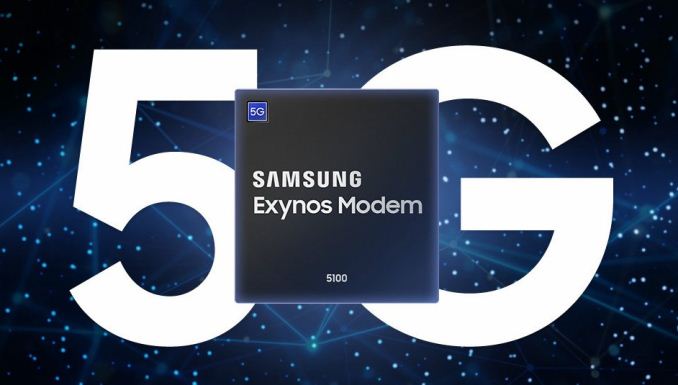Samsung Releases Exynos Modem 5100 - First Multi-Mode 5G Modem
by Andrei Frumusanu on August 15, 2018 5:10 AM EST
Today Samsung announced its new Exynos Modem 5100 – what it claims to be the industry’s first multi-mode 5G modem.
While over the last few months, and years, we’ve heard a lot of news regarding 5G modems from various vendors, in particular Qualcomm’s new X50 modem – Samsung S.LSI tends to avoid much public PR fanfare until its products are near release. We’ve heard rumours about the new 5G modem being presented earlier this year at MWC but couldn’t get any more details out from Samsung.
Today’s launch differs in the sense that the Exynos Modem 5100 claims to be the first multi-mode modem solution – meaning the new chipset is a full standalone solution supporting the new 5G sub-6GHz and mmWave as well as all existing standards, including 2G GSM/CDMA, 3G WCDMA, TD-SCDMA, HSPA, and 4G LTE. This comes in contrast with Qualcomm's X50 modem which requires the SoC modem to provide the legacy connectivity option in order to provide platform multi-mode functionality. Where Samsung would have a definite advantage is integration into products that don't implement any connectivity in the first place.
In terms of specifications, the new modem supports 8x carrier aggregation in both 5G NR as well as LTE – it promises to achieve LTE category 19 download speeds of up to 1.6Gbps, 5G sub-6GHz speeds of up to 2Gbps and 5G mmWave speeds of up to 6Gbps. For 5G NR this means we’re working with 8x 100MHz channels summing up to 800MHz of bandwidth, versus 8x 20MHz / 160MHz for LTE radios.
Uplink bandwidth is implemented with up to 2x carrier aggregation in 5G NR and LTE. For both downlink and uplink, the mmWave connectivity is implemented with 64-QAM versus 256-QAM for the sub-6GHz bands.
The new modem comes with accompanying RF IC / radio front-ends, envelope tracker and power management ICs. Samsung implements the Exynos Modem 5100 on a 10LPP manufacturing node – while this might come at a disadvantage to eventual 7nm parts from the competition, Samsung promises commercial availability by the end of 2018, giving Samsung seemingly a lead in terms of time to market if everything pans out as claimed.
Related Reading
- Qualcomm Announces New X50 5G Modem, First Gigabit Class LTE Network and Router
- Qualcomm Announces Their First 5G mmWave Antenna Module: QTM052, Coming This Year
- 3GPP Completes First 5G NR Specification For Release 15
- Intel Announces XMM 8060 5G & XMM 7660 Category 19 LTE Modems, Both Due in 2019
- CEVA Announces PentaG 5G NR Modem IP Platform
Source: Samsung Press Release










17 Comments
View All Comments
wrkingclass_hero - Wednesday, August 15, 2018 - link
Yay, microwave radiation!Andrei Frumusanu - Wednesday, August 15, 2018 - link
Better have that tinfoil hat on to protect against satellite transmissions!Dr. Swag - Wednesday, August 15, 2018 - link
Wifi is still at much higher frequencies lolbaka_toroi - Wednesday, August 15, 2018 - link
But Wifi has much lower signal strength than 5G.Santoval - Wednesday, August 15, 2018 - link
Actually 5G (and I mean mmWave 5G, since sub-6GHz 5G is as fast as 4G LTE Category 20) is stronger than WiFi only in the sense that the mobile towers provide a stronger signal, i.e. with many more watts.Watt for watt WiFi is stronger, penetrates walls and floors easily (mmWave 5G cannot, so it is ruled out for in-building connections, where it will have to fall back to sub-6GHz mode) and it has a longer range.
That's because it uses a lower frequency. Higher frequencies provide faster speeds, but at the trade-off of all the above. mmWave 5G will also require a much higher density of mobile towers/antennas, due to its longer range, so it will be more costly to telcos and take much longer to be deployed, but even when it is deployed, there should be many "dark spots" remaining.
This is why 5G has a <6 GHz and mmWave frequency mode.
bcronce - Wednesday, August 15, 2018 - link
IR is much higher frequency and much high wattage. Your skin is bathed in nearly a kilowatt of IR at room temperate. The only danger from microwave radiation that we know of and predict is localized heating. The heat from your cellphones battery is more dangerous than the wifi.wrkingclass_hero - Wednesday, August 15, 2018 - link
It's the heating that's dangerous, it can damage DNA structure. The reason why people hear clicking and scratching noises when they are exposed to microwave radiation is because the heat is causing parts of their inner ears to expand. The Fire Department has banned the placement of cell towers around fire stations because they found that it was affecting their ability to think. Keep in mind that your brain does not have any pain receptors, only the blood vessels in your brain do, and the fact that people typically keep cell phones pressed against their heads when in use that's a bad combo.Diji1 - Thursday, August 16, 2018 - link
Lunacy.N Zaljov - Wednesday, August 15, 2018 - link
"...while this might come at a disadvantage to eventual 7nm parts from the competition, ..."I don't know where I exactly got it from, but I read that Qualcomm's SDX50 is supposedly manufactured on 10LPP as well, coming in at a die size of around 95 mm² (don't slap me if I'm wrong here, I'm just relying on rumors...). It will be interesting to see the actual energy-consumption of these "monsters", especially during 5G transmission.
Andrei Frumusanu - Wednesday, August 15, 2018 - link
AFAIK, Qualcomm hasn't confirmed details on the X50, only stating that in the future they'll use 7LPP for manufacturing:https://www.qualcomm.com/news/releases/2018/02/21/...